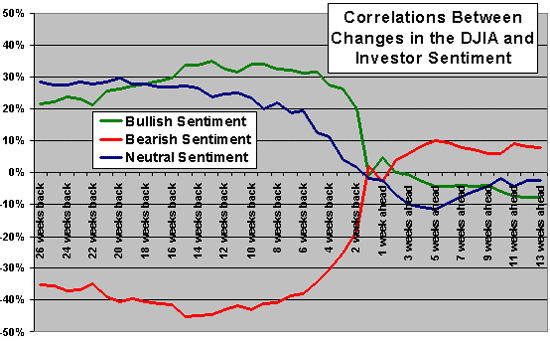Jeff Walker invites visitors to the “Current Investor Sentiment” page at Lowrisk.com to express their market sentiment by predicting the direction of the Dow Jones Industrial Average (DJIA) over the next few weeks. He also generously offers weekly historical results of this ongoing poll back to May 1997. How well does this measure of investor sentiment predict the actual behavior of the DJIA?
To answer this question, we download historical weekly poll results from May 1997 through December 2004 (399 weeks) and weekly historical DJIA data from May 1997 to the present. We then calculate for each sentiment data point the change in the DJIA for 39 intervals ranging from the 26-week period leading up to the sentiment measurement date to the 13-week period after the sentiment measurement date. Using Pearson correlations to compare sentiment values with DJIA behavior over each of the 39 intervals allows us to determine whether investor sentiment is more reactive to the past or predictive of the future.
The following chart depicts the results of this analysis. It shows that investor sentiment, as measured via the Lowrisk.com poll, is generally reactive rather than predictive. Bullish (bearish) sentiment tends to rise (fall) after the stock market has risen, and vice versa. Sentiment is very weakly contrarian with respect to future stock market behavior; there is almost no correlation between sentiment and future market moves. What predictive power sentiment has is likely due to a slight tendency of the stock market to reverse after a move up or down.

The chart suggests that sentiment is most strongly related to the behavior of the market over the past three months. It hints that bears, with the higher absolute correlation values, latch onto the past more strongly than do bulls. It also indicates that those who claim neutral sentiment may be bulls in disguise rather than truly neutral.
In summary, investor sentiment tends to “predict” the past.
While poll participants may exhibit diversity and independence of action, they probably lack private information relevant to the future direction of the market.